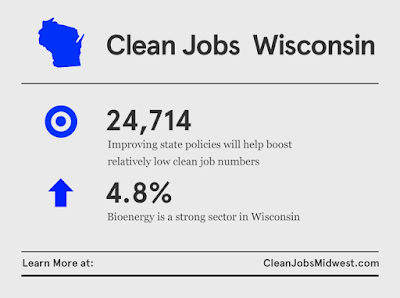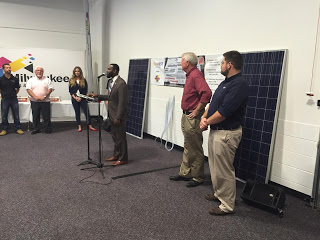
by jboullion | Jul 27, 2016 | Uncategorized
RENEW Honors Businesses Investing in Solar Energy
In the span of one week, RENEW presented “Solar Champion” awards to three companies—JONCO Industries, Central Storage & Warehouse and O&H Danish Bakery–that now host some of the largest rooftop solar electric systems in the state of Wisconsin. The award presentations took place during individual ribbon-cutting ceremonies at each company, two of which were organized and emceed by RENEW’s incoming president Amy Heart. The three PV systems honored by RENEW have a combined rated capacity of about 1.26 MW(DC) .
 |
Speaking at JONCO’s ribbon cutting is Rep. David Bowen,
joined by Tom Ryan & his son, Leah Maggio of Focus on Energy,
Mayor Tom Barrett, and John Daugherty of SunVest. |
Located in Milwaukee’s North Side, JONCO Industries hosts a new 370-kilowatt array on a 200,000-square-foot building it acquired in 2014 to expand its contract manufacturing capabilities. A number of local dignitaries, including Milwaukee Mayor Tom Barrett, gathered on July 13 to praise JONCO’s achievement in integrating clean energy into his company’s operations. Said JONCO president Tom Ryan: “If we want to invest the money and time to build the rooftop solar. I’m not looking for today, but I’ve calculated it out — it’s going to take me four years to pay for that roof.”
On behalf of RENEW and Pewaukee-based SunVest, which designed and installed the array, RENEW Executive Director Tyler Huebner presented a certificate recognizing JONCO Industries as “the largest solar electricity producer among Wisconsin manufacturing companies.”
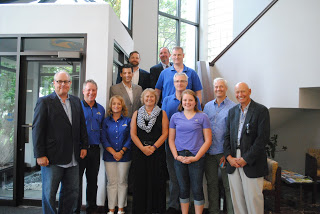 |
The SunPeak team standing with CS&W owners
Jack & Ken Williams (extreme right). |
Read more on JONCO’s solar installation in a Milwaukee Journal Sentinel article.
Later that day, Central Storage & Warehouse (CS&W), a Madison-based, family-owned company that owns several refrigerated warehouses in Wisconsin, hosted an event celebrating its 2,904-panel solar system. The 741-kilowatt system designed and installed by Madison-based SunPeak is sized to produce 20% of the electricity consumed at the adjoining warehouse, which was rebuilt after a devastating fire in 1991 that melted food in storage worth millions of dollars.
At the celebration Madison Mayor Paul Soglin and RENEW Program and Policy Director Michael Vickerman congratulated CS&W for embracing environmental performance and clean energy as it rebuilt its physical plant in the ensuing 25 years. This rebuilding culminated with the installation of the largest rooftop solar electric system in the state. SunPeak and RENEW presented a certificate to CS&W Vice President Jack Williams honoring the company’s leadership in advancing solar energy for Wisconsin businesses. Both Williams and Vickerman also praised the Focus on Energy program for providing critical funding support for this precedent-setting installation.
For more information about CS&W’s solar installation, visit SunPeak’s website.
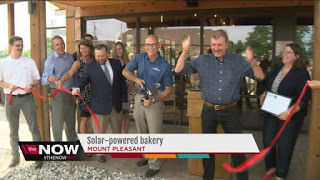 |
O&H co-owner Eric Olesen cutting the ribbon while Rep.
Cory Mason, Michael Vickerman, and Amy Heart look on. |
|
RENEW and SunVest teamed up again the following week to organize a ribbon-cutting ceremony for a 152-kilowatt solar system atop O&H Danish Bakery’s new headquarters building in Mount Pleasant, near Racine. O&H built the 44,000-square-foot facility in 2015 to house all of its baking operations under one roof. The solar panels atop O&H’s roof should produce 180,000 kilowatt-hours a year, supplying about 25% of the electricity used in that building. O&H’s Mount Pleasant facility will enable the renowned Kringle maker to add about 25 new positions over the next three years.
RENEW’s new president, Amy Heart, presided over the ceremony, which attracted such local dignitaries as Rep. Cory Mason and M.T. Boyle, who represented Racine County Executive Jonathan Delagrave. Several years ago, Rep. Mason authored legislation designating the Kringle as Wisconsin’s official pastry. Wrapping up, RENEW’s Michael Vickerman presented a Solar Champion certificate to O&H co-owner Eric Olesen, recognizing the company’s status as the largest solar electricity producer in Racine County and the largest solar electricity producer among Wisconsin bakeries.
Read more about O&H’s solar installation in a piece from TMJ4.
All three solar electric systems will enable these signature Wisconsin businesses to manage their energy costs more effectively and strengthen their economic position in the highly competitive business environments they operate in. Focus on Energy funding support was instrumental in persuading these economic mainstays to plow their own savings into solar. The Public Service Commission will soon decide whether to continue rebates for renewable energy in 2017 and 2018. We hope to enlist these and other renewable energy hosts to educate the PSC on the positive connection between their renewable energy investments and the health of their businesses.

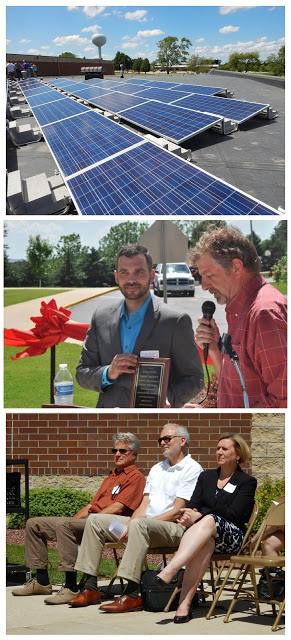
by jboullion | Jun 6, 2016 | Uncategorized
 The Darlington Community School District kicked off the month of June with a ribbon-cutting
The Darlington Community School District kicked off the month of June with a ribbon-cutting
ceremony in honor of its solar electric system installed late last year and energized this winter.The 156 kilowatt array atop the elementary-middle school is, according to RENEW’s project data base, the largest photovoltaic array serving a public school system in the state.
A southwest Wisconsin community with a population of nearly 2,500, Darlington is the seat of government in Lafayette County. There are about 800 students enrolled in the school district.
Under blazing sunshine and a cobalt blue sky, RENEW’s Michael Vickerman presented a plaque to Darlington School Board president Aaron Wolfe honoring the district’s achievement in becoming “the largest solar electricity producer of any K-12 school district in Wisconsin.”
Vickerman said: “We are delighted to present this award to you not only to recognize your great achievement with this solar installation, but also to inspire other school districts in Wisconsin to equal or surpass what you’ve accomplished here in Darlington.”
Consisting of 510 panels expected to generate 200,000 kilowatt-hours/year, Darlington’s array is sized to supply 25% of the electricity consumed at both the high school and the neighboring elementary school. The school district expects to save about $11,500 annually in electricity costs.
Working closely with Madison solar consultant Niels Wolter, the school district obtained a $63,000 renewable energy incentive from Focus on Energy and a $61,000 grant from U.S. Department of Agriculture’s Rural Energy for America Program. Midwest-based solar investors also provided funding for the installation.
The district also received Hoffman’s 2016 TPM ™ sustainability award from Mark Hanson, Director of Sustainable Services, with Appleton-based Hoffman Planning, Design and Construction, Inc., which provided solar planning services.
After the ribbon was cut, Lee Black, the district’s buildings and grounds manager, shepherded a group up to the roof to view the installation and answer questions.
For more information on the Darlington Solar Education Project, visit their website here.
Real-time monitoring information from the Darlington array can be accessed here.
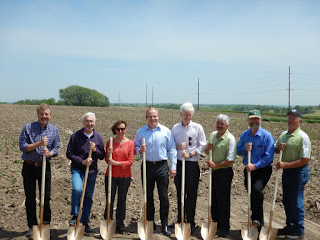
by jboullion | May 31, 2016 | Uncategorized
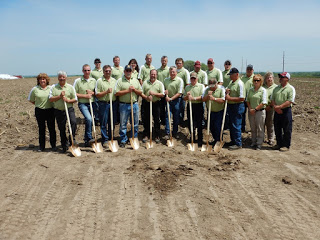 Representatives from Dairyland Power Cooperative, Richland Electric Cooperative, SoCore Energy and others gathered May 23rd on a sun-baked Richland County crop field
Representatives from Dairyland Power Cooperative, Richland Electric Cooperative, SoCore Energy and others gathered May 23rd on a sun-baked Richland County crop field
to celebrate a breakthrough moment for utility-scale solar energy in
Wisconsin. The symbol for this breakthrough is a 600 kilowatt (AC) solar
array that will, when completed, supply 500 kW of electricity to
Dairyland Power and 100 kW directly to Richland Electric under a 25 year
contract.
The third participant in the groundbreaking ceremony, Chicago-based SoCore Energy, will build and own the Richland solar station as well as 10 others across western Wisconsin. La Crosse-based Dairyland Power and its host cooperatives will purchase the entire output from SoCore’s 11 arrays, which will total more than 14 megawatts.
Highlighting the course change that Dairyland and its member cooperatives are committed to, every Richland Electric employee present at the ceremony wore green shirts emblazoned with “Transition Energy.” This fact sheet contains more details on Richland’s Transition Energy initiative.
Presiding over the ceremony were Barb Nick, Dairyland Power’s CEO, and Shannon Clark, Richland Electric’s general manager. Both speakers praised solar power’s emergence as a clean, cost-effective, and locally available source of energy that complements the western Wisconsin landscape. Consisting of nearly 2,400 panels, SoCore’s array will occupy about one-half of an eight-acre parcel next to a Dairyland substation alongside State Highway 56.
[RENEW note: Barb Nick will be the keynote speaker at RENEW’s Energy Policy Summit set for January 2017.]
At the groundbreaking, Richland’s Clark unveiled details of the shared solar component to the project, which it calls the Ash Ridge Community Solar Project. Nearly 400 310-watt panels will be dedicated to Richland’s shared solar service, which is available to all of the cooperative’s 3,500 owner-members. The one-time subscription fee per panel is $699. The per-kilowatt- hour credit to subscribers will equal the cooperative’s retail energy rate.
Also participating in the groundbreaking were State Senator Jennifer Shilling, and State Assembly members Ed Brooks and Lee Nerison. WXOW-TV, Channel 19 in La Crosse, broadcast a segment on the groundbreaking that evening and aired a lengthier segment on solar energy’s breakthrough moment the following morning.
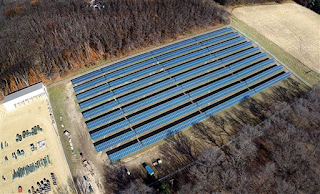
by jboullion | May 11, 2016 | Uncategorized
A letter to customers in Xcel Wisconsin’s territory from RENEW’s Michael Vickerman appeared in the
La Crosse Tribune on April 26, 2016:
 |
Eau Claire Energy Cooperative’s
872 kW Community Solar Array |
With declining costs, solar electricity has become an increasingly affordable option for property owners wishing to power their homes with clean energy.
But what options are available for solar energy enthusiasts who have shading problems or roofs that need replacement within the next five years? And is there any path available for renters who want solar but don’t own the roof over their heads?
There is an option for La Crosse-area customers of Xcel Energy—every customer now can “plug in” to a community solar garden and reap the benefit of that clean energy directly on their electric bills.
With the recent rollout of Xcel’s Solar*Connect Community program, residential and business customers are stepping up to purchase a share in the output through up-front subscriptions that will likely be paid back in full after 20 years. Hopefully, their early action will inspire others in La Crosse and surrounding communities to join in and reap the solar harvest.
Grouping thousands of solar panels into one large array lowers the unit cost of the project to participants. Through this structure, every participating utility customer will share equitably in this clean power installation at a low cost.
Another segment of the community that benefits from shared solar is the nonprofit sector, which can solicit tax-deductible contributions from its members or donors to become solar buyers. Indeed, community solar is a great way for a benefactor to bestow a clean energy legacy for a particular school, nature center or house of worship.
Solar projects like these do not drop out of the sky and magically land in your community. These arrays are going up in western Wisconsin because the people there and utilities such as Xcel believe that their communities are ready to launch the transition to clean energy, and they worked hard to make these projects happen. They also believe that solar is a cost-effective energy option today when customers are given the opportunity to step up and support it.
La Crosse-area residents and businesses are fortunate to have this opportunity to take their energy future into their own hands. To Xcel customers living in the area, we at RENEW encourage you to make the most of this opportunity and enroll in your local solar program. There is no clearer way to show the world where you and your community stand on clean energy.
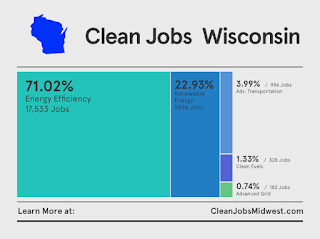
by jboullion | Mar 28, 2016 | Uncategorized
By: Tyler Huebner, Executive Director, RENEW Wisconsin
Last week, two reports came out that demonstrate the incredible value of Wisconsin’s Focus on Energy program to our state’s citizens and economy.
Focus on Energy is the program that people and businesses across the state use for rebates, advice, and technical support to save money by using less energy.
The first was a report issued by a group called the Clean Energy Trust. It showed the number of people across 12 Midwest states who work in the delivery of energy saving products and services and renewable energy technologies.
In Wisconsin, we have nearly 25,000 people working in these industries according to the report. Companies like Miron Construction in Neenah, Broadwind Towers in Manitowoc, Cree Lighting in Racine, Trane in La Crosse, and countless small businesses throughout the state are delivering energy solutions for businesses and residents.
However, of the twelve Midwestern states surveyed, Wisconsin ranked last in the number of persons working in these industries on a per capita basis. The report clearly shows that Wisconsin has a tremendous opportunity to tap these sectors for further employment growth.
The second report was a draft “Strategic Energy Assessment” from the state of Wisconsin’s Public Service Commission. This report showed that Wisconsin has the highest electricity rates of eight Midwestern states.
 |
Sisters of St. Francis Solar Installation, which was made
possible by a Focus on Energy Rebate. |
However, because our citizens use energy more efficiently, our monthly energy bills aren’t the highest. In fact, our monthly bills are among the lowest in the region.
The Public Service Commission identified the energy-smart nature of our citizens and specifically pointed to the Focus on Energy program for enabling citizens to save money on their monthly bills.
It’s against the backdrop of these reports that our Legislature has recently passed a bill, AB 804, that cuts $7 million each year out of Wisconsin’s highly successful Focus on Energy program. The bill is sitting on the Governor’s desk, and it is my understanding that the Governor has the ability to line-item veto that provision in the bill.
Funding for Focus on Energy should be kept whole.
Focus on Energy delivers $3.33 in savings for every dollar invested. The program keeps energy bills lower for citizens and businesses, despite Wisconsin’s higher rates. Focus on Energy is supporting thousands of jobs, but Wisconsin is behind our neighboring states. A cut to this program will only make that gap larger.
More jobs. Less waste. Saving money. Common sense goals for a stronger Wisconsin, and Focus on Energy is delivering. Let’s keep this program strong now, and for years to come.

by jboullion | Mar 22, 2016 | Uncategorized
FOR IMMEDIATE RELEASE
PRESS CONTACTS: Tyler Huebner, Tyler.Huebner@renewwisconsin.org, 608-575-2201; Pat Mitchell, pmitchell@hastingsgroup.com, 703-276-3266; Jeff Benzak, jeff@e2.org; 202-513-6248.
New Report: Nearly 25,000 Clean Energy Workers in Wisconsin
Projected 2016 Growth Rate of 4.8 Percent; Milwaukee, Rural Areas Each Account for Quarter of State’s Jobs; Energy Efficiency, Renewables Standards Could Create Even More Opportunities
MADISON (March 22, 2016) – Nearly 25,000 people work in Wisconsin’s clean energy industry, according to a comprehensive analysis unveiled today by RENEW Wisconsin, Clean Energy Trust and Environmental Entrepreneurs (E2).
The analysis – available at www.CleanJobsMidwest.com – is based on U.S. Bureau of Labor Statistics data and a comprehensive survey of thousands of businesses across Wisconsin and the 12-state Midwest region. The Clean Jobs Midwest report provides detailed breakdowns of clean energy jobs not available previously – including job totals for every county, congressional district and state legislative district in Wisconsin.
“As a leading wind tower manufacturer in the U.S., Broadwind draws on Wisconsin’s deep manufacturing heritage to fabricate wind turbine towers in our Manitowoc facility,” said Eric Blashford, president of Broadwind Towers and Heavy Industries, referring to the company’s Wisconsin location on Lake Michigan between Milwaukee and Green Bay.
“This same facility that once built submarines for World War II currently employs nearly 300 people in Manitowoc, most of whom are high-skilled manufacturing staff receiving competitive pay and a good benefits package.”
“As Wisconsin transitions to a clean energy economy, many more of these well-paying jobs will be created throughout the supply chain helping Wisconsinites make a good, stable living,” Blashford said.
Energy efficiency is by far the largest clean energy sector employer in the state, with more than 17,000 people, or nearly 71 percent of the clean energy workforce, employed in areas such as high-efficiency lighting, Energy Star appliance manufacturing and high-efficiency HVAC services to reduce wasted energy in homes, schools and businesses.
According to the findings, the renewable energy industry accounts for about one in four clean energy workers in Wisconsin, or more than 5,600 jobs – including about 3,700 in solar, 1,100-plus in biomass and nearly 600 in wind. Wisconsin is one of two Midwestern states with more than 20 percent of its renewable energy generation coming from biomass.
“Wisconsin’s clean energy workers make up an important and growing sector of our economy,” said Tyler Huebner, executive director of RENEW Wisconsin. “Our last major state energy policy advancement was made ten years ago now, and although we met the goals including 10 percent renewable electricity by 2015, that policy is no longer driving investment. A new policy framework for advancing 21st-century energy solutions would create even more clean energy employment and help us catch up with our neighboring states. Clean energy policies drive job growth across the Midwest and have the potential to help create thousands of good-paying jobs in Wisconsin as well,” Huebner said.
The report also found:
– Most clean energy jobs in Wisconsin – nearly 7,500 – are found in rural areas and non-metropolitan statistical areas. The greater Milwaukee area boasts nearly 6,500 clean energy jobs.
– In contrast to Governor Scott Walker’s policy opposing the federal Clean Power Plan, nearly 68 percent of clean energy businesses in the state believe the Clean Power Plan would increase business prospects.
– Clean energy employs nearly 569,000 people across the 12-state Midwest region (Illinois, Indiana, Iowa, Kansas, Michigan, Minnesota, Missouri, Nebraska, North Dakota, Ohio, South Dakota, and Wisconsin).
“Clean energy is a dynamic sector and central to economic growth in the Midwest,” said Erik Birkerts, Chief Executive Officer of Clean Energy Trust. “Smart public policy will further accelerate the clean energy sector’s growth, which means thousands of new jobs created across the region and which will confer economic advantages on Wisconsin,” Birkerts continued.
Learn more about Wisconsin clean energy jobs here, and access additional resources for each state and region here.
RENEW Wisconsin leads and accelerates the transformation to Wisconsin’s renewable energy future through advocacy, education, and collaboration.
Clean Energy Trust (CET) fuels clean energy innovation in the Midwest. A Chicago-based non-profit, CET helps launch, fund and grow Midwest clean energy companies to ensure a more prosperous, sustainable future for generations to come. It does this through direct investment, commercialization assistance, mentorship, access to its broad partner network and the promotion of a supportive clean energy community and business climate. Learn more at http://www.cleanenergytrust.org.
Environmental Entrepreneurs (E2) is a national, nonpartisan group of business leaders, investors, and professionals from every sector of the economy who advocate for smart policies that are good for the economy and good for the environment. Our members have founded or funded more than 2,500 companies, created more than 600,000 jobs, and manage more than $100 billion in venture and private equity capital. For more information, see www.e2.org or follow us on Twitter at @e2org.












